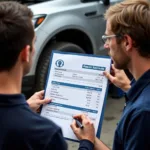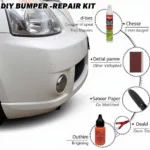Repairing a scratched black plastic car bumper can seem daunting, but with the right techniques and a little patience, you can restore your bumper to its former glory. This guide will provide a step-by-step approach to tackling those unsightly scratches, from minor scuffs to deeper gouges.
Learn how to assess the damage, choose the right repair method, and execute the repair effectively. We’ll cover everything from simple DIY solutions to more advanced techniques, ensuring you have the knowledge to confidently repair your scratched black plastic car bumper. After reading this guide, you’ll be equipped to handle those pesky scratches and get your car looking its best. For more in-depth information on specific bumper repairs, check out our guide on car bumper scratches repair.
Assessing the Damage: Light vs. Deep Scratches
Before you start any repair, it’s crucial to assess the depth of the scratch. This will determine the best course of action. Light scratches, often appearing as white marks, usually only affect the clear coat or the very top layer of paint. Deep scratches, on the other hand, penetrate the color coat and sometimes even the primer, exposing the plastic underneath.
Identifying Light Scratches
Light scratches can often be addressed with simple cleaning and polishing. Run your fingernail across the scratch. If it doesn’t catch, it’s likely a light scratch.
Identifying Deep Scratches
If your fingernail catches on the scratch, it’s considered deep and will require more extensive repair. Deep scratches require filling, sanding, and repainting.
DIY Repair Methods for Light Scratches
For light scratches, a few DIY methods can effectively remove the blemish. These methods are cost-effective and can be done at home.
-
Cleaning and Polishing: Thoroughly clean the area with car wash soap and water. Then, apply a rubbing compound or polishing compound designed for plastic bumpers, followed by a plastic trim restorer.
-
Scratch Remover Products: Many commercial scratch remover products are specifically formulated for plastic bumpers. Follow the product instructions carefully for best results.
Repairing Deep Scratches: A Step-by-Step Guide
Deep scratches require a more involved process. Here’s a step-by-step guide:
-
Clean the Area: Clean the scratched area thoroughly with soap and water. Remove any dirt or debris.
-
Sand the Scratch: Use fine-grit sandpaper (e.g., 2000-grit) to smooth the edges of the scratch and remove any loose paint.
-
Apply Plastic Filler: If the scratch has penetrated the plastic, apply a plastic filler specifically designed for bumpers. Follow the product instructions for drying times.
-
Sand the Filler: Once the filler is dry, sand it smooth using progressively finer grits of sandpaper.
-
Prime the Area: Apply a primer to the repaired area to ensure proper paint adhesion.
-
Paint the Area: Apply several thin coats of black paint specifically designed for plastic bumpers. Allow each coat to dry before applying the next.
-
Apply Clear Coat: Once the paint is dry, apply a clear coat to protect the repair and restore shine.
You can find more helpful tips on repairing car bumpers at how to repair scratches on bumper of car.
“A common mistake people make is using abrasive cleaners on deep scratches,” says John Smith, Senior Automotive Technician at Smith’s Auto Repair. “This can actually worsen the damage. Always start with the least abrasive method and work your way up.”
Professional Car Bumper Repair
While DIY repairs can be effective for minor scratches, deep or complex damage may require professional attention. A professional car repair shop can provide expert repairs and ensure a seamless finish. If you are unsure about tackling the repair yourself, consider consulting a professional.
For those located in Blackburn, you can find reliable car bumper repair services at car bumper repair blackburn. Also, check our guide on car plastic bumper scratch repair for more specific repair options.
Conclusion
Repairing a scratched black plastic car bumper can be a manageable task with the right approach. By assessing the damage and choosing the appropriate repair method, you can restore your bumper and maintain your car’s appearance. Remember to always prioritize safety and use the correct tools and materials. With a little patience and effort, you can achieve professional-looking results and keep your car looking its best. For further assistance on fixing scratches on your car bumper, refer to our guide on how to repair scratches on car bumper.
FAQ
-
Can I use regular spray paint on a plastic bumper? No, you should use paint specifically designed for plastic bumpers to ensure proper adhesion and durability.
-
How long does it take for plastic filler to dry? Drying times vary depending on the product, so always refer to the manufacturer’s instructions.
-
What grit sandpaper should I use for sanding plastic filler? Start with a coarser grit (e.g., 180-grit) and gradually move to finer grits (e.g., 2000-grit) for a smooth finish.
-
Do I need to apply a primer before painting? Yes, applying a primer is essential for proper paint adhesion and a professional-looking finish.
-
Can I repair a cracked plastic bumper? Minor cracks can sometimes be repaired using plastic adhesive or filler, but larger cracks may require professional repair or bumper replacement.
-
How can I prevent future scratches on my bumper? Be mindful of parking and avoid bumping into objects. Applying a protective film or coating can also help prevent scratches.
-
What should I do if the scratch is very deep and exposes the metal underneath? Deep scratches exposing metal require professional repair to prevent rust and further damage.
“Remember, preparation is key,” advises Maria Garcia, Lead Auto Body Technician at Garcia’s Auto Body. “Taking the time to properly clean and prepare the surface will significantly impact the final result of your repair.”
Need more help? Check out these related articles: How to Repair a Dent in a Car Bumper, How to Choose the Right Car Wax for Your Black Car.
Need expert assistance? Contact us via WhatsApp: +1(641)206-8880, Email: [email protected]. Our 24/7 customer support team is ready to help!


